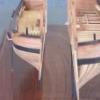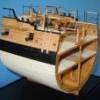-
Posts
470 -
Joined
-
Last visited
Reputation Activity
-
 Erik W got a reaction from dgbot in 18th Century Longboat by Erik W - FINISHED - Model Shipways - Scale 1:48 - First wooden ship build
Erik W got a reaction from dgbot in 18th Century Longboat by Erik W - FINISHED - Model Shipways - Scale 1:48 - First wooden ship build
Mike,
Here are the links Mike (Stuntflyer) sent me. He had said the top one was the most useful to him. That short video (in the top link) on seizing was very helpful in understanding that.
http://modelshipworld.com/index.php?/topic/5295-rigging-blocks-how-to/
http://www.modelboatyard.com/stropping.html
http://modelshipworld.com/index.php/topic/7277-stropping-and-seizing/
http://modelshipworld.com/index.php?/topic/3145-hooks-and-blocks/?hl=seize
Also, I found some good advice on how to handle things here:
http://modelshipworld.com/index.php/topic/9180-how-to-work-with-teeny-blocks/
The part of the rigging that was confounding me was fastening the two blocks to the top of the mast. I had sent Chuck a message and his response was:
"Remember that the block must be oriented in the right direction. Meaning on those blocks the hole is on top if you are using the blocks that come with the kit. I basically took a length of rope and put it through the eye on the metal band first and tied a knot. The two tails were left extra long. Then I used the two tails to strop the block in position afterwards. You can use a drop of glue to fix the block against the original knot so it stays there. Then tie a simple knot with the tails around the block. Not a double knot.....just one time so you can trim the tails after applying some glue. This way you cant see its a big knot at the bottom of the block afterwards."
Hope this helps you a bit.
Erik
-
 Erik W got a reaction from Ryland Craze in 18th Century Longboat by Erik W - FINISHED - Model Shipways - Scale 1:48 - First wooden ship build
Erik W got a reaction from Ryland Craze in 18th Century Longboat by Erik W - FINISHED - Model Shipways - Scale 1:48 - First wooden ship build
I had a pretty frustrating evening the other night. I dove right into the rigging thing . . . and wound up with pretty crappy results. The nylon rope that came with the kit was hard to work with, being inflexible, stiff, slippery, etc. That, and I hadn't researched enough what I was doing . . . so felt pretty defeated. But, thanks to Chuck answering a late night message, I placed an order with him for quality replacement rope, and Mike (Stuntflyer) was kind enough to point me towards some good links on basic rigging techniques. My hat is off to both Chuck and Mike for bringing me back to an even keel. And yet again . . . I've learned that patience is the name of the game.
The other thing I needed was a workable 3rd hand system. I came up with this, since I don't own anything that would work otherwise. I flipped the wood around in two clothes pins and tapered the new front, and then glued them to my build board. One oriented on it's side, the other upright. Should work fine to hold blocks for seizing and stropping.
Erik
-
 Erik W got a reaction from Stuntflyer in 18th Century Longboat by Erik W - FINISHED - Model Shipways - Scale 1:48 - First wooden ship build
Erik W got a reaction from Stuntflyer in 18th Century Longboat by Erik W - FINISHED - Model Shipways - Scale 1:48 - First wooden ship build
Mike,
Here are the links Mike (Stuntflyer) sent me. He had said the top one was the most useful to him. That short video (in the top link) on seizing was very helpful in understanding that.
http://modelshipworld.com/index.php?/topic/5295-rigging-blocks-how-to/
http://www.modelboatyard.com/stropping.html
http://modelshipworld.com/index.php/topic/7277-stropping-and-seizing/
http://modelshipworld.com/index.php?/topic/3145-hooks-and-blocks/?hl=seize
Also, I found some good advice on how to handle things here:
http://modelshipworld.com/index.php/topic/9180-how-to-work-with-teeny-blocks/
The part of the rigging that was confounding me was fastening the two blocks to the top of the mast. I had sent Chuck a message and his response was:
"Remember that the block must be oriented in the right direction. Meaning on those blocks the hole is on top if you are using the blocks that come with the kit. I basically took a length of rope and put it through the eye on the metal band first and tied a knot. The two tails were left extra long. Then I used the two tails to strop the block in position afterwards. You can use a drop of glue to fix the block against the original knot so it stays there. Then tie a simple knot with the tails around the block. Not a double knot.....just one time so you can trim the tails after applying some glue. This way you cant see its a big knot at the bottom of the block afterwards."
Hope this helps you a bit.
Erik
-
 Erik W got a reaction from Ryland Craze in 18th Century Longboat by Erik W - FINISHED - Model Shipways - Scale 1:48 - First wooden ship build
Erik W got a reaction from Ryland Craze in 18th Century Longboat by Erik W - FINISHED - Model Shipways - Scale 1:48 - First wooden ship build
Mike,
Here are the links Mike (Stuntflyer) sent me. He had said the top one was the most useful to him. That short video (in the top link) on seizing was very helpful in understanding that.
http://modelshipworld.com/index.php?/topic/5295-rigging-blocks-how-to/
http://www.modelboatyard.com/stropping.html
http://modelshipworld.com/index.php/topic/7277-stropping-and-seizing/
http://modelshipworld.com/index.php?/topic/3145-hooks-and-blocks/?hl=seize
Also, I found some good advice on how to handle things here:
http://modelshipworld.com/index.php/topic/9180-how-to-work-with-teeny-blocks/
The part of the rigging that was confounding me was fastening the two blocks to the top of the mast. I had sent Chuck a message and his response was:
"Remember that the block must be oriented in the right direction. Meaning on those blocks the hole is on top if you are using the blocks that come with the kit. I basically took a length of rope and put it through the eye on the metal band first and tied a knot. The two tails were left extra long. Then I used the two tails to strop the block in position afterwards. You can use a drop of glue to fix the block against the original knot so it stays there. Then tie a simple knot with the tails around the block. Not a double knot.....just one time so you can trim the tails after applying some glue. This way you cant see its a big knot at the bottom of the block afterwards."
Hope this helps you a bit.
Erik
-
 Erik W got a reaction from MikeB4 in 18th Century Longboat by Erik W - FINISHED - Model Shipways - Scale 1:48 - First wooden ship build
Erik W got a reaction from MikeB4 in 18th Century Longboat by Erik W - FINISHED - Model Shipways - Scale 1:48 - First wooden ship build
Mike,
Here are the links Mike (Stuntflyer) sent me. He had said the top one was the most useful to him. That short video (in the top link) on seizing was very helpful in understanding that.
http://modelshipworld.com/index.php?/topic/5295-rigging-blocks-how-to/
http://www.modelboatyard.com/stropping.html
http://modelshipworld.com/index.php/topic/7277-stropping-and-seizing/
http://modelshipworld.com/index.php?/topic/3145-hooks-and-blocks/?hl=seize
Also, I found some good advice on how to handle things here:
http://modelshipworld.com/index.php/topic/9180-how-to-work-with-teeny-blocks/
The part of the rigging that was confounding me was fastening the two blocks to the top of the mast. I had sent Chuck a message and his response was:
"Remember that the block must be oriented in the right direction. Meaning on those blocks the hole is on top if you are using the blocks that come with the kit. I basically took a length of rope and put it through the eye on the metal band first and tied a knot. The two tails were left extra long. Then I used the two tails to strop the block in position afterwards. You can use a drop of glue to fix the block against the original knot so it stays there. Then tie a simple knot with the tails around the block. Not a double knot.....just one time so you can trim the tails after applying some glue. This way you cant see its a big knot at the bottom of the block afterwards."
Hope this helps you a bit.
Erik
-
 Erik W got a reaction from mtaylor in 18th Century Longboat by Erik W - FINISHED - Model Shipways - Scale 1:48 - First wooden ship build
Erik W got a reaction from mtaylor in 18th Century Longboat by Erik W - FINISHED - Model Shipways - Scale 1:48 - First wooden ship build
Mike,
Here are the links Mike (Stuntflyer) sent me. He had said the top one was the most useful to him. That short video (in the top link) on seizing was very helpful in understanding that.
http://modelshipworld.com/index.php?/topic/5295-rigging-blocks-how-to/
http://www.modelboatyard.com/stropping.html
http://modelshipworld.com/index.php/topic/7277-stropping-and-seizing/
http://modelshipworld.com/index.php?/topic/3145-hooks-and-blocks/?hl=seize
Also, I found some good advice on how to handle things here:
http://modelshipworld.com/index.php/topic/9180-how-to-work-with-teeny-blocks/
The part of the rigging that was confounding me was fastening the two blocks to the top of the mast. I had sent Chuck a message and his response was:
"Remember that the block must be oriented in the right direction. Meaning on those blocks the hole is on top if you are using the blocks that come with the kit. I basically took a length of rope and put it through the eye on the metal band first and tied a knot. The two tails were left extra long. Then I used the two tails to strop the block in position afterwards. You can use a drop of glue to fix the block against the original knot so it stays there. Then tie a simple knot with the tails around the block. Not a double knot.....just one time so you can trim the tails after applying some glue. This way you cant see its a big knot at the bottom of the block afterwards."
Hope this helps you a bit.
Erik
-
 Erik W reacted to MikeB4 in 18th Century Longboat by Erik W - FINISHED - Model Shipways - Scale 1:48 - First wooden ship build
Erik W reacted to MikeB4 in 18th Century Longboat by Erik W - FINISHED - Model Shipways - Scale 1:48 - First wooden ship build
Eric,
Where can you get those basic rigging tips?
Mike
-
 Erik W got a reaction from Mike Y in 18th Century Longboat by Erik W - FINISHED - Model Shipways - Scale 1:48 - First wooden ship build
Erik W got a reaction from Mike Y in 18th Century Longboat by Erik W - FINISHED - Model Shipways - Scale 1:48 - First wooden ship build
I had a pretty frustrating evening the other night. I dove right into the rigging thing . . . and wound up with pretty crappy results. The nylon rope that came with the kit was hard to work with, being inflexible, stiff, slippery, etc. That, and I hadn't researched enough what I was doing . . . so felt pretty defeated. But, thanks to Chuck answering a late night message, I placed an order with him for quality replacement rope, and Mike (Stuntflyer) was kind enough to point me towards some good links on basic rigging techniques. My hat is off to both Chuck and Mike for bringing me back to an even keel. And yet again . . . I've learned that patience is the name of the game.
The other thing I needed was a workable 3rd hand system. I came up with this, since I don't own anything that would work otherwise. I flipped the wood around in two clothes pins and tapered the new front, and then glued them to my build board. One oriented on it's side, the other upright. Should work fine to hold blocks for seizing and stropping.
Erik
-
 Erik W got a reaction from dgbot in 18th Century Longboat by Erik W - FINISHED - Model Shipways - Scale 1:48 - First wooden ship build
Erik W got a reaction from dgbot in 18th Century Longboat by Erik W - FINISHED - Model Shipways - Scale 1:48 - First wooden ship build
I had a pretty frustrating evening the other night. I dove right into the rigging thing . . . and wound up with pretty crappy results. The nylon rope that came with the kit was hard to work with, being inflexible, stiff, slippery, etc. That, and I hadn't researched enough what I was doing . . . so felt pretty defeated. But, thanks to Chuck answering a late night message, I placed an order with him for quality replacement rope, and Mike (Stuntflyer) was kind enough to point me towards some good links on basic rigging techniques. My hat is off to both Chuck and Mike for bringing me back to an even keel. And yet again . . . I've learned that patience is the name of the game.
The other thing I needed was a workable 3rd hand system. I came up with this, since I don't own anything that would work otherwise. I flipped the wood around in two clothes pins and tapered the new front, and then glued them to my build board. One oriented on it's side, the other upright. Should work fine to hold blocks for seizing and stropping.
Erik
-
 Erik W got a reaction from egkb in 18th Century Longboat by Erik W - FINISHED - Model Shipways - Scale 1:48 - First wooden ship build
Erik W got a reaction from egkb in 18th Century Longboat by Erik W - FINISHED - Model Shipways - Scale 1:48 - First wooden ship build
I had a pretty frustrating evening the other night. I dove right into the rigging thing . . . and wound up with pretty crappy results. The nylon rope that came with the kit was hard to work with, being inflexible, stiff, slippery, etc. That, and I hadn't researched enough what I was doing . . . so felt pretty defeated. But, thanks to Chuck answering a late night message, I placed an order with him for quality replacement rope, and Mike (Stuntflyer) was kind enough to point me towards some good links on basic rigging techniques. My hat is off to both Chuck and Mike for bringing me back to an even keel. And yet again . . . I've learned that patience is the name of the game.
The other thing I needed was a workable 3rd hand system. I came up with this, since I don't own anything that would work otherwise. I flipped the wood around in two clothes pins and tapered the new front, and then glued them to my build board. One oriented on it's side, the other upright. Should work fine to hold blocks for seizing and stropping.
Erik
-
 Erik W got a reaction from Jack12477 in 18th Century Longboat by Erik W - FINISHED - Model Shipways - Scale 1:48 - First wooden ship build
Erik W got a reaction from Jack12477 in 18th Century Longboat by Erik W - FINISHED - Model Shipways - Scale 1:48 - First wooden ship build
I had a pretty frustrating evening the other night. I dove right into the rigging thing . . . and wound up with pretty crappy results. The nylon rope that came with the kit was hard to work with, being inflexible, stiff, slippery, etc. That, and I hadn't researched enough what I was doing . . . so felt pretty defeated. But, thanks to Chuck answering a late night message, I placed an order with him for quality replacement rope, and Mike (Stuntflyer) was kind enough to point me towards some good links on basic rigging techniques. My hat is off to both Chuck and Mike for bringing me back to an even keel. And yet again . . . I've learned that patience is the name of the game.
The other thing I needed was a workable 3rd hand system. I came up with this, since I don't own anything that would work otherwise. I flipped the wood around in two clothes pins and tapered the new front, and then glued them to my build board. One oriented on it's side, the other upright. Should work fine to hold blocks for seizing and stropping.
Erik
-
 Erik W got a reaction from Canute in 18th Century Longboat by Erik W - FINISHED - Model Shipways - Scale 1:48 - First wooden ship build
Erik W got a reaction from Canute in 18th Century Longboat by Erik W - FINISHED - Model Shipways - Scale 1:48 - First wooden ship build
I had a pretty frustrating evening the other night. I dove right into the rigging thing . . . and wound up with pretty crappy results. The nylon rope that came with the kit was hard to work with, being inflexible, stiff, slippery, etc. That, and I hadn't researched enough what I was doing . . . so felt pretty defeated. But, thanks to Chuck answering a late night message, I placed an order with him for quality replacement rope, and Mike (Stuntflyer) was kind enough to point me towards some good links on basic rigging techniques. My hat is off to both Chuck and Mike for bringing me back to an even keel. And yet again . . . I've learned that patience is the name of the game.
The other thing I needed was a workable 3rd hand system. I came up with this, since I don't own anything that would work otherwise. I flipped the wood around in two clothes pins and tapered the new front, and then glued them to my build board. One oriented on it's side, the other upright. Should work fine to hold blocks for seizing and stropping.
Erik
-
 Erik W got a reaction from Matrim in 18th Century Longboat by Erik W - FINISHED - Model Shipways - Scale 1:48 - First wooden ship build
Erik W got a reaction from Matrim in 18th Century Longboat by Erik W - FINISHED - Model Shipways - Scale 1:48 - First wooden ship build
I had a pretty frustrating evening the other night. I dove right into the rigging thing . . . and wound up with pretty crappy results. The nylon rope that came with the kit was hard to work with, being inflexible, stiff, slippery, etc. That, and I hadn't researched enough what I was doing . . . so felt pretty defeated. But, thanks to Chuck answering a late night message, I placed an order with him for quality replacement rope, and Mike (Stuntflyer) was kind enough to point me towards some good links on basic rigging techniques. My hat is off to both Chuck and Mike for bringing me back to an even keel. And yet again . . . I've learned that patience is the name of the game.
The other thing I needed was a workable 3rd hand system. I came up with this, since I don't own anything that would work otherwise. I flipped the wood around in two clothes pins and tapered the new front, and then glued them to my build board. One oriented on it's side, the other upright. Should work fine to hold blocks for seizing and stropping.
Erik
-
 Erik W got a reaction from dvm27 in 18th Century Longboat by Erik W - FINISHED - Model Shipways - Scale 1:48 - First wooden ship build
Erik W got a reaction from dvm27 in 18th Century Longboat by Erik W - FINISHED - Model Shipways - Scale 1:48 - First wooden ship build
I finished the oars, the last of the wood work on the boat. Like others, I'll only display 4 of them in the boat. No one really mentions shaping the oars, but after struggling to get one shaped correctly, I figured out the trick. The laser cut oar handles are .064" (1.63mm) thick, by .090" (2.29mm) wide. If you file off the four edges so you have an octagon, it's not symmetrical. Your oar handle then will be oblong rather than round. I wound up sanding the .090" (2.29mm) side down to .064" (1.63mm) first. I then was able to sand the handle perfectly round. Using my digital calipers I was able to check all 4 handles several places along their length to make sure they were uniform .062" (1.57mm) diameter when finished. Also, when carefully comparing the photos in Chuck's original build log, these laser cut oars are 1/2" too long. So, I removed 1/2" off of the length so they won't overpower the boat interior when displayed.
In preparation for rigging, and tying small knots, I bought a magnifying lamp. It is 2x with a spot that is 5x, and contains a bright LED light.
Erik
-
 Erik W got a reaction from avsjerome2003 in 18th Century Longboat by Erik W - FINISHED - Model Shipways - Scale 1:48 - First wooden ship build
Erik W got a reaction from avsjerome2003 in 18th Century Longboat by Erik W - FINISHED - Model Shipways - Scale 1:48 - First wooden ship build
The mast, bowsprit, boom, and gaff are now complete. The couple inches of snow on the ground this morning here in Colorado is a reminder that it will soon be too cold to stain/poly in the garage, so I'm shaping the oars next, since they're the last wood, besides the base, that will get stain/poly.
Erik
-
 Erik W reacted to jonny.amy in 18th Century Longboat by jonny.amy - Model Shipways
Erik W reacted to jonny.amy in 18th Century Longboat by jonny.amy - Model Shipways
Hi Guys,
Sorry the photo's haven't been published earlier, I was hoping to add another few of them to the collection last night, but spent the evening sanding out a water stain from the wood flooring in the entrance hall to our flat, and then walking the dog.
So as for progress on the model, I've made a big jump ahead in the activities. I've finished the planking on both the Port and Starboard sides of the hull, broken out the inner parts of bulkheads, sanded them down, and have installed the caprails to the longboat. I have also managed to get some paint on to the model. I need to carry on sanding the inner faces of the caprails, and touch up the paint, but I'm getting there.
I have applied the frieze to Stern by doubling up the transom. Although this isn't called for in the instructions, it was (to me) the most logical way of applying the frieze square and true.
The hull has been painted off-white all the way up to the frieze as a nod towards the longboat of HMS Victory at Portsmouth Dockyard. Although the contemporary model at the National Maritime Museum shows the unpainted topsides (above the waterline and below the frieze), I decided not to follow suit, and try something a bit different. My reckoning is that all the topsides would have been painted to act as a means of waterproofing the planks. Although, I might be wrong.
Please feel free to comment on this!
As for the Lego brick Ropewalk, it works, but needs a rethink. Unfortunately the kit that I bought had no gears in it (I bought the kit in a catalogue store), so I had to work on basic mechanical principles.
Here it is set up on the Kitchen work top. It's a bit jerky in operation, but makes rope. It is a two man job as one hand is required to turn the spindles and cranks and the other is required to keep tension on the fixed end. The moving end also requires turning to keep the tension in the rope.
This is the outcome... I think it looks ok, but does not even compare to the stuff Chuck can produce.
Cheers
Jonny
-
 Erik W reacted to Dan Vadas in HMS Vulture 1776 by Dan Vadas - FINISHED - 1:48 scale - cross-section - from TFFM books
Erik W reacted to Dan Vadas in HMS Vulture 1776 by Dan Vadas - FINISHED - 1:48 scale - cross-section - from TFFM books
Thank you John, Ben, David and Greg.
All the frames have been assembled, now I can start fitting them to the keel.
I started by gluing the three Deadflat frames together, using spacers and Fillers of the appropriate thickness :
Then I set the assembly up on the board, using the acrylic square I built for Vulture's frames. A little bit of finessing on the slots for the keel was needed to get a good tight fit. The board and square, and also the two temporary supports, ensure that each frame goes up correctly :
Danny
-
 Erik W reacted to Chuck in 18th century English Longboat by Chuck - FINISHED - c.1760
Erik W reacted to Chuck in 18th century English Longboat by Chuck - FINISHED - c.1760
I will ship anywhere in the world....
You will need 1 pack of 3/32" singles 1 pack of 1/8 singles 1 pack of .008 tan 1 pack of .012 tan 1 pack of .018 black 1 pack of .012 black 1 pack of .008 black
Chuck
-
 Erik W got a reaction from Stuntflyer in 18th Century Longboat by Erik W - FINISHED - Model Shipways - Scale 1:48 - First wooden ship build
Erik W got a reaction from Stuntflyer in 18th Century Longboat by Erik W - FINISHED - Model Shipways - Scale 1:48 - First wooden ship build
Danny,
Thanks. I had seen how some oars (sweeps) even had squared off outer ends before the hand grip. The balance thing makes sense. I figured I'd pattern mine after the oars on Chuck's build, as well as the prototype longboat model photos on the National Maritime Museum website, which have uniform diameter handles on them.
Erik
-
 Erik W got a reaction from avsjerome2003 in 18th Century Longboat by Erik W - FINISHED - Model Shipways - Scale 1:48 - First wooden ship build
Erik W got a reaction from avsjerome2003 in 18th Century Longboat by Erik W - FINISHED - Model Shipways - Scale 1:48 - First wooden ship build
I finished the oars, the last of the wood work on the boat. Like others, I'll only display 4 of them in the boat. No one really mentions shaping the oars, but after struggling to get one shaped correctly, I figured out the trick. The laser cut oar handles are .064" (1.63mm) thick, by .090" (2.29mm) wide. If you file off the four edges so you have an octagon, it's not symmetrical. Your oar handle then will be oblong rather than round. I wound up sanding the .090" (2.29mm) side down to .064" (1.63mm) first. I then was able to sand the handle perfectly round. Using my digital calipers I was able to check all 4 handles several places along their length to make sure they were uniform .062" (1.57mm) diameter when finished. Also, when carefully comparing the photos in Chuck's original build log, these laser cut oars are 1/2" too long. So, I removed 1/2" off of the length so they won't overpower the boat interior when displayed.
In preparation for rigging, and tying small knots, I bought a magnifying lamp. It is 2x with a spot that is 5x, and contains a bright LED light.
Erik
-
 Erik W got a reaction from Canute in 18th Century Longboat by Erik W - FINISHED - Model Shipways - Scale 1:48 - First wooden ship build
Erik W got a reaction from Canute in 18th Century Longboat by Erik W - FINISHED - Model Shipways - Scale 1:48 - First wooden ship build
Danny,
Thanks. I had seen how some oars (sweeps) even had squared off outer ends before the hand grip. The balance thing makes sense. I figured I'd pattern mine after the oars on Chuck's build, as well as the prototype longboat model photos on the National Maritime Museum website, which have uniform diameter handles on them.
Erik
-
 Erik W got a reaction from mtaylor in 18th Century Longboat by Erik W - FINISHED - Model Shipways - Scale 1:48 - First wooden ship build
Erik W got a reaction from mtaylor in 18th Century Longboat by Erik W - FINISHED - Model Shipways - Scale 1:48 - First wooden ship build
Danny,
Thanks. I had seen how some oars (sweeps) even had squared off outer ends before the hand grip. The balance thing makes sense. I figured I'd pattern mine after the oars on Chuck's build, as well as the prototype longboat model photos on the National Maritime Museum website, which have uniform diameter handles on them.
Erik
-
 Erik W reacted to Dan Vadas in 18th Century Longboat by Erik W - FINISHED - Model Shipways - Scale 1:48 - First wooden ship build
Erik W reacted to Dan Vadas in 18th Century Longboat by Erik W - FINISHED - Model Shipways - Scale 1:48 - First wooden ship build
Nice Sweeps Erik. One point to note in future is that the outer ends of them flare out wider before cutting back to the handgrips. This aids in balancing them.
See THIS link to the ones I made for the longboat in a bottle.
Danny
-
 Erik W got a reaction from Stuntflyer in 18th Century Longboat by Erik W - FINISHED - Model Shipways - Scale 1:48 - First wooden ship build
Erik W got a reaction from Stuntflyer in 18th Century Longboat by Erik W - FINISHED - Model Shipways - Scale 1:48 - First wooden ship build
I finished the oars, the last of the wood work on the boat. Like others, I'll only display 4 of them in the boat. No one really mentions shaping the oars, but after struggling to get one shaped correctly, I figured out the trick. The laser cut oar handles are .064" (1.63mm) thick, by .090" (2.29mm) wide. If you file off the four edges so you have an octagon, it's not symmetrical. Your oar handle then will be oblong rather than round. I wound up sanding the .090" (2.29mm) side down to .064" (1.63mm) first. I then was able to sand the handle perfectly round. Using my digital calipers I was able to check all 4 handles several places along their length to make sure they were uniform .062" (1.57mm) diameter when finished. Also, when carefully comparing the photos in Chuck's original build log, these laser cut oars are 1/2" too long. So, I removed 1/2" off of the length so they won't overpower the boat interior when displayed.
In preparation for rigging, and tying small knots, I bought a magnifying lamp. It is 2x with a spot that is 5x, and contains a bright LED light.
Erik
-
 Erik W got a reaction from Jack12477 in 18th Century Longboat by Erik W - FINISHED - Model Shipways - Scale 1:48 - First wooden ship build
Erik W got a reaction from Jack12477 in 18th Century Longboat by Erik W - FINISHED - Model Shipways - Scale 1:48 - First wooden ship build
I finished the oars, the last of the wood work on the boat. Like others, I'll only display 4 of them in the boat. No one really mentions shaping the oars, but after struggling to get one shaped correctly, I figured out the trick. The laser cut oar handles are .064" (1.63mm) thick, by .090" (2.29mm) wide. If you file off the four edges so you have an octagon, it's not symmetrical. Your oar handle then will be oblong rather than round. I wound up sanding the .090" (2.29mm) side down to .064" (1.63mm) first. I then was able to sand the handle perfectly round. Using my digital calipers I was able to check all 4 handles several places along their length to make sure they were uniform .062" (1.57mm) diameter when finished. Also, when carefully comparing the photos in Chuck's original build log, these laser cut oars are 1/2" too long. So, I removed 1/2" off of the length so they won't overpower the boat interior when displayed.
In preparation for rigging, and tying small knots, I bought a magnifying lamp. It is 2x with a spot that is 5x, and contains a bright LED light.
Erik












